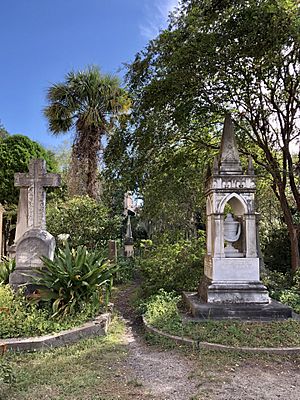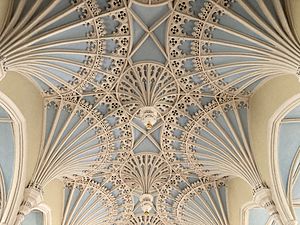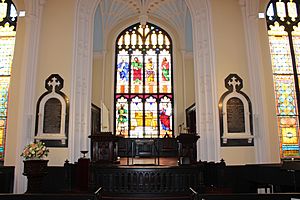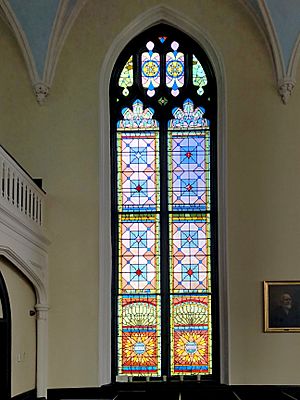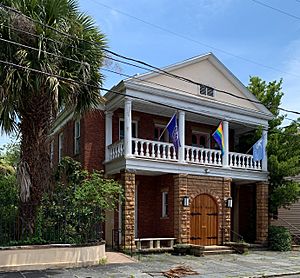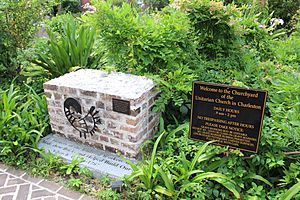Unitarian Church in Charleston facts for kids
Quick facts for kids Unitarian Church in Charleston |
|
|---|---|
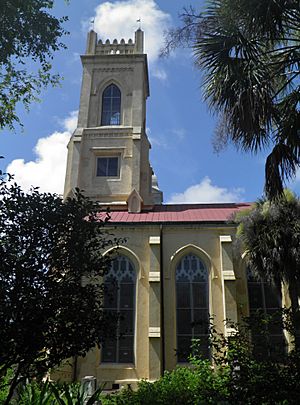
The Unitarian Church in Charleston
|
|
| Religion | |
| Affiliation | Unitarian Universalist Association |
| Leadership | The Reverend Rebecca Hinds, Minister
Community Minister, Rev. Nathan Woodliff-Stanley |
| Location | |
| Location | 4 Archdale Street, Charleston, South Carolina, U.S.A. |
| Architecture | |
| Architect(s) | Francis D. Lee |
| Architectural style | English Gothic architecture |
| Completed | 1787 |
| Website | |
| Unitarian Church in Charleston | |
The Unitarian Church in Charleston is a very old and important church in Charleston, South Carolina. It's home to a Unitarian Universalist group. This church is special because it's the oldest Unitarian church in the Southern United States. It's also the second oldest church building on the Charleston peninsula.
The church is known for its work on social justice issues. It has received special recognition for being a welcoming place for everyone. It also has a "Green Sanctuary" certification for its care for the environment.
In 1976, the Unitarian Church in Charleston was named a National Historic Landmark. This means it's a very important historical site. You can visit the church for tours at certain times. It also hosts public concerts, talks, and events about important social topics. You can find more details on the church's website.
Contents
How the Church Began
The Unitarian Church in Charleston started as a second building for another church. This church, called the Independent Church, needed more space. So, they began building this new meeting house in 1772. It was almost finished in 1776 when the Revolutionary War started.
During the war, both American and British soldiers used the building. Because of this, it needed a lot of repairs after the war ended. The building, unofficially called the Archdale Street Meeting House, was finally ready in 1787.
For 30 years, both churches worked together. They shared the same ministers and even the same sermons each Sunday. In 1815, one of the ministers, Reverend Anthony Forster, changed his religious beliefs. He became a Unitarian, which is a different type of Christian faith.
This change caused the church to split in 1817. About half of the members left to form a new, independent church. This new group met in the Archdale Meeting House. The original Independent Church is now the Circular Congregational Church. The new church was officially named the Second Independent Church of Charleston in 1817.
Reverend Anthony Forster became ill and passed away in 1819. After him, Samuel Gilman became the minister. He was a graduate of Harvard College and a Unitarian. He helped the church fully become Unitarian. Samuel Gilman also wrote Harvard's school song, Fair Harvard.
Samuel Gilman's wife, Caroline Howard Gilman, was a famous writer. She was inspired to create the beautiful churchyard next to the church in the 1830s. It was designed as a peaceful place for people to visit. Samuel Gilman served as minister until he passed away in 1858. The church officially joined the American Unitarian Association in 1839. It was then named the Unitarian Church in Charleston.
A New Look for the Church
In 1852, the church decided to make its building bigger and more beautiful. They hired Francis D. Lee, a young architect and church member. He was inspired by famous English buildings like the Chapel of Henry VII at Westminster Abbey.
Francis D. Lee worked with another architect, Edward C. Jones, to complete the project. They raised the roof of the building by four feet. They also added a Chancel, which is the area around the altar. They built special supports called false flying buttresses to make the church look more like a Gothic building. The tower was also made taller.
The inside of the church was designed to look like English Gothic churches. It has a special fan-vaulted ceiling, a long central area called a nave, and a chancel. The stained glass windows were considered some of the best in the country. This church might have been one of the first Gothic-style buildings in the United States. This style is called English Perpendicular Gothic Revival.
The large window in the Chancel was made in 1854 by Henry E. Sharp glass works. This window shows scenes from both the Old and New Testaments. It features Moses and Aaron with the Ark of the Covenant at the bottom. Above them are the four Gospel writers.
The church's interior was also updated with new pews, a pulpit, and a communion rail. These were all made from walnut wood. Gas lighting was also added at this time.
Challenges: War and Disasters
During the American Civil War, many church members left Charleston. The church closed its doors until 1865. Soon after the war began, a large fire swept through Charleston in 1861. It destroyed five churches but stopped just two blocks from the Unitarian Church.
From 1863 to 1865, Union forces attacked Charleston. The church was within range of their cannons but was not damaged.
Charleston surrendered in February 1865, and the church reopened. However, many members had lost their money or did not return. This made it hard for the church financially. Luckily, a member named Alva Gage had kept most of his money. He generously helped the church during these tough times.
Around this time, the Universalist Church in Charleston closed. Its remaining members joined the Unitarian Church. They also donated their funds to help repair the church. Unitarians and Universalists officially joined together in 1961.
The church survived the Civil War without major damage. But it faced big challenges during two natural disasters in 1885 and 1886.
In 1885, a strong hurricane hit Charleston with winds of 125 miles per hour. This storm blew out all the windows in the main part of the church. New side windows were donated by Unitarian churches in Boston. These windows are in the Art Nouveau style, which looks different from the older windows. They are made of solid stained glass and show themes from the Old and New Testaments.
The next year, in 1886, a huge earthquake hit Charleston. It caused major damage to the Unitarian Church. The top part of the church tower fell through the roof. This destroyed part of the beautiful fan-vaulted ceiling.
Again, Unitarians from all over the country helped. They donated $17,000 for repairs. A Boston architect named Thomas Silloway restored the inside of the church to its original design. However, the tower was rebuilt in a simpler way. This was done to make it stronger and safer if another earthquake happened.
More than 100 years later, in 1989, Hurricane Hugo hit Charleston. It destroyed about 30 large trees in the churchyard. These trees were replaced with smaller ones like dogwood and Japanese maple. The storm also damaged over 60 tombstones. A project called the Larrisey Gravestone Conservation Project was started to repair them. So far, 65 tombstones have been fixed.
The Church Campus Today
Today, the church has a 1.3-acre campus. It includes the church building, a lovely churchyard, Gage Hall, and a Religious Education Annex. The main church building is often called "the Landmark" because it was named a National Historical Landmark in 1976.
In 2005, the outside of the church was cleaned and repaired. In 2010, the inside was also fixed up and repainted. It remains a beautiful example of fan-vaulting and a peaceful place for quiet thought.
The churchyard is a green space in the middle of Charleston. You can enter it from King Street or Archdale Street. It's also part of Charleston's Gateway Walk. While no famous people are buried there, the churchyard is filled with many different plants and flowers that bloom all year. Camellias and roses grow near a sundial and a monument honoring Samuel and Caroline Gilman.
Across the churchyard from the church is Gage Hall. This building was built in 1893. It has offices, meeting rooms, and a large hall for concerts and parties. Gage Hall was once famous for its debates on important topics, which were even broadcast on the radio in the 1960s.
The church also hosted one of the first Head Start programs in Charleston. Volunteers from the church helped teach children and provided lunches. Today, coffeehouse concerts are held regularly at Gage Hall. The money raised helps fund field trips for children from inner-city schools.
Gage Hall is named after Alva Gage, who supported the church for many years. He provided money for the building and left much of his fortune to the church. He is buried in the churchyard.
In 2013, a new entrance was made in the church wall to allow wheelchair access. This meant removing many of the original bricks. The church decided to use these bricks to build a memorial. This monument honors the enslaved people who helped build the church. It is in the churchyard near the church entrance.
The memorial has a metal bird looking backward. This bird is a Sankofa, an African symbol. It means "learning from the past to move forward." An inscription on the monument dedicates it to "the enslaved workers who made these bricks and helped build our church."
The Religious Education Annex is located behind Gage Hall. It was built in 1997-98 and has classrooms. It also has an apartment for the church sexton.
See also
- Unitarian Universalist Association
- List of National Historic Landmarks in South Carolina
- National Register of Historic Places listings in Charleston, South Carolina


